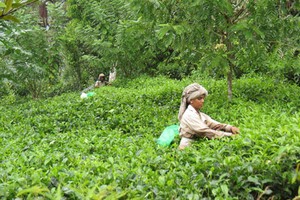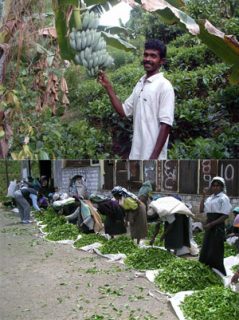Besides providing for many of our needs, forests play a pivotal role in providing ecosystem services, ranging from biodiversity conservation to climate regulation. Yet over the last decade the world has lost an average of more than 5 million hectares of forests every year. Different examples show that marketing forest products can have a very positive impact, leading to higher incomes and also to healthier ecosystems.

Analog Forestry (AF) is a silviculture method that mimics the natural structure and function of a particular seral stage of an ecosystem. Its main objective is to restore the natural ecosystems, and to implement modified ecosystems with the same ecological functions as the natural ones.
By re-creating a forest system’s composition, structure and function, AF systems can help to increase food security and resilience to climate change – while also creating income-generating opportunities.
Products such as plant fibres, medicinal herbs, spices, wild fruits, honey and many others, are known as Non-Timber Forest Products, or NTFPs. Analog Forestry methods aim at obtaining these products through a design system (see box) that helps farmers to manage the land where they work, using the available resources while preventing degradation. Most NTFPs are harvested in a traditional way, so it is generally thought that only small quantities are involved. Yet the income-generating potential of NTFPs should not be underestimated: in India, for example, the majority of forest revenues come from NTFPs.
It is estimated that 60% of honey in the Indian market is harvested from the wild. There is also a widespread misperception that the price for such products should be low – despite the traditional knowledge involved and the risks communities undergo in order to harvest the produce – because they were not planted and taken care of in a conventional production system.
There is an even larger challenge from logging, mining or other extractive industries which decrease the areas available for wild harvesting and make sustainable management and natural regeneration more difficult. However, different examples show that the commercialisation of these products can not only help improve the incomes and opportunities of the rural population, but can also help preserve forest resources.
Certification for marketing

Third party certification, using the Forest Garden Products (FGP) label, is an emerging possibility for NTFPs in different parts of the world. An FGP label reflects a set of production standards which are currently under revision in the International Federation of Organic Agriculture Movements (IFOAM) family of standards.
FGP certification is carried out by inspectors authorised by the International Analog Forestry Network (IAFN). This type of certification is primarily designed for high value export products, because of the costs of involving a third party. Experience shows that a Participatory Guarantee System (PGS) is more suited for products that are sold in local markets. This is a less expensive method and the process also helps strengthen communities.
In general, a PGS is based on a peer review system, whereby farmers, consumers and other stakeholders verify compliance with a set of standards defining the production methods and product quality. These standards are decided upon internally by the group, and can contain any pertinent criteria ranging from organic methods to sustainable wild harvesting.
The method of inspection is agreed collectively, and is usually done by a selected group that takes turns to make the visits and exchange and share information about products and the production process. Often this task is done on a voluntary basis.
The benefits of a PGS include creating a brand name and community building. The brand name is based on the standards employed by the group (which often focus on organic agriculture). Products with a known or recognised brand can be sold at a premium as they can show that, having followed a given process, they are of a better quality than conventional products. When interested producers join a PGS, they are also joining a community that can support them and share information. Thus, a PGS can raise production standards not only through compliance to criteria, but also through peer education.
Products such as spices, tea and guarana are being certified as Forest Garden Products and as a result are reaching some European markets. At the same time, different PGS are being developed for smallscale producers in local markets where exports are not a priority. These local markets are helping farmers and producers, as well as supporting the development of Analog Forestry.
In Sri Lanka, Rainforest Rescue International (RRI) has helped farmers’ cooperatives with the production and commercialisation of their tea and spices. These co-operatives market their certified products using Analog Forestry as their production method. This enables them to address the challenges of environmental conservation and restoration of the forested area around their communities whilst also meeting their financial needs. RRI trains these communities in environmentally- friendly low-input production systems, encouraging farmers and communities to engage in forest restoration and seed saving programmes in the country’s arid northern region.
Similar results have emerged from the work of the Centre for Nursery Development and Eru Propagation (CENDEP) in Cameroon. As partners of IAFN, they promote Analog Forestry in all their projects and are currently supporting the commercialisation of eru (Gnetum spp.) and other products such as honey through a participatory certification process.
Adding value
Analog Forestry differs from other silviculture practices in that, in the long term, it seeks to reach the same level of maturity as an original forest. In the short and mid term, the objectives will vary according to the producers’ needs. These are based on an assessment of the ecosystem structure, comparing a given area with a healthy ecosystem. A roadmap towards the regeneration of the soil and the forest is then established to help practitioners restore the landscape and biodiversity while producing consumable and/or marketable products. The benefits of AF systems include enhancing the carbon cycle, providing pollinators with new niches and contributing to the formation of condensation cloud nuclei, which help with water conservation and stabilise precipitation patterns. The IAFN is still at the beginning of what may be a long, but worthwhile, process of engaging communities in new ways of connecting with their ecosystems.
Value can be added by using a label or brand associated with a set of production standards, such as third-party or participatory guarantee systems, but it also involves processing or transformation. This can vary from packaging wholesale quantities of honey into retail-sized jars with information labels, to drying leaves and other plant parts to create special blends (i.e. curries or teas). The benefits for consumers are obvious: better access to products and, just as importantly, higher quality products.
Farmers see also many advantages. Processed eru attracts a price that is five times higher than the unprocessed product. CENDEP is showing how the involvement of farming groups in a PGS can lead to considerably higher income levels.
A PGS can cover several different food (and non-food) crops, such as cereals, beans and vegetables, as long as the best practices associated with the PGS are ascertained and communicated to consumers. Further market studies still need to be undertaken in order to determine the revenue streams associated with the PGS process; however, CENDEP’s experience with two NTFPs (eru and honey) show the potential of a steady increase in incomes. At the moment, the group of participants has grown to more than 300 families, representing 6 communities.
The benefits can be even broader, as the “added value” is also seen in the forest ecosystems. This is very clear in Cameroon, with the (re-)introduction of native species such as eru, or trees like Anarcadium occidentalis, red mahogany or Ilex metis.
Local forests, local markets
The inherent species richness in AF systems promotes diversified income streams by providing multiple products that offer a variety of processing and marketing opportunities. For example, systems that produce spices, such as vanilla, nutmeg, cinnamon and black pepper, also produce cut flowers, animal fodder, rice, beans, bamboo, and plants for essential oils such as patchouli and orange leaves. While much effort is required to get these and other NTFPs into high-end markets in northern countries, it should be remembered that most of these products are consumed in their countries and regions of origin. This suggests that more attention needs be paid to developing new market opportunities at the local level.
So instead of focusing on one or a few products, we feel that it is better to promote the sustainable management of the forests, increase biodiversity, restore landscapes and provide a wider array of products to be consumed locally. Analog Forestry can be used as a tool to produce commercial products while preserving the structure and function of ecosystems, and a PGS process can help develop local markets for these products.
Eduardo Aguilar and Cavan Gates
Eduardo Aguilar (eduardo@analogforestrynetwork.org) and Cavan Gates work at the Secretariat of the International Analog Forestry Network (IAFN).
For more information, visit their websites: www.foresteriaanaloga.org ; www.analogforestrynetwork.org

